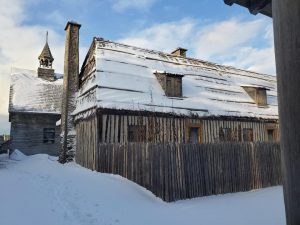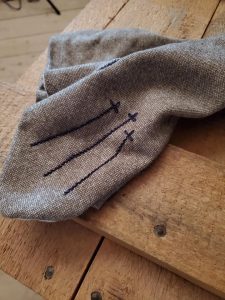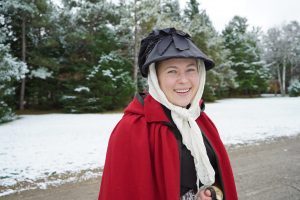 With winter settling in on the Straits of Mackinac, it can be difficult to image what life was like here in the 18th century. When guests visit Colonial Michilimackinac during the summer months, they get to see staff dressed for warm weather, but people often wonder: what did they do they when it got cold?
With winter settling in on the Straits of Mackinac, it can be difficult to image what life was like here in the 18th century. When guests visit Colonial Michilimackinac during the summer months, they get to see staff dressed for warm weather, but people often wonder: what did they do they when it got cold?
For most women living at Michilimackinac year-round, the first thing to think about was changing the type of textiles that they were wearing. Light-weight summer wools and linens would be swapped for warmer or heavier layers. Wool was the obvious answer and imported from Europe in abundance. Some wools were so soft that they were more than comfortable to wear next to the skin while others were coarser and better suited for outerwear.
 Silk was another winter fabric option. It was lightweight, came in an amazing array of colors and allowed for less bulk. It has the ability to hold heat close to the body and is still used for long underwear today. In the 18th century it was used for mitts, petticoats, gowns, neckerchiefs, stockings, hats, and cloaks. Fur was another warm option but considered to be a little too bulky to make into a full garment. It was used more often as a trim for cloaks, gowns and for accessories such as muffs and mittens.
Silk was another winter fabric option. It was lightweight, came in an amazing array of colors and allowed for less bulk. It has the ability to hold heat close to the body and is still used for long underwear today. In the 18th century it was used for mitts, petticoats, gowns, neckerchiefs, stockings, hats, and cloaks. Fur was another warm option but considered to be a little too bulky to make into a full garment. It was used more often as a trim for cloaks, gowns and for accessories such as muffs and mittens.
 Another option was to mix fabrics. Petticoats or skirts could be quilted with wool or down between the layers of wool or silk. Some women also wore quilted under-waistcoats that were meant to hold the heat close to the body and be hidden under their other clothing. Cloaks with hoods were sometimes lined and quilted with eiderdown to keep the head and core especially warm.
Another option was to mix fabrics. Petticoats or skirts could be quilted with wool or down between the layers of wool or silk. Some women also wore quilted under-waistcoats that were meant to hold the heat close to the body and be hidden under their other clothing. Cloaks with hoods were sometimes lined and quilted with eiderdown to keep the head and core especially warm.
The key to staying warm for the 18th century woman was to choose the right fabrics and layer up. If you are interested in seeing 18th century women’s winter clothing in action, come to Colonial Michilimackinac on December 11 for a celebration of the holiday season. For more information or tickets visit mackinacparks.com/a-colonial-christmas.









